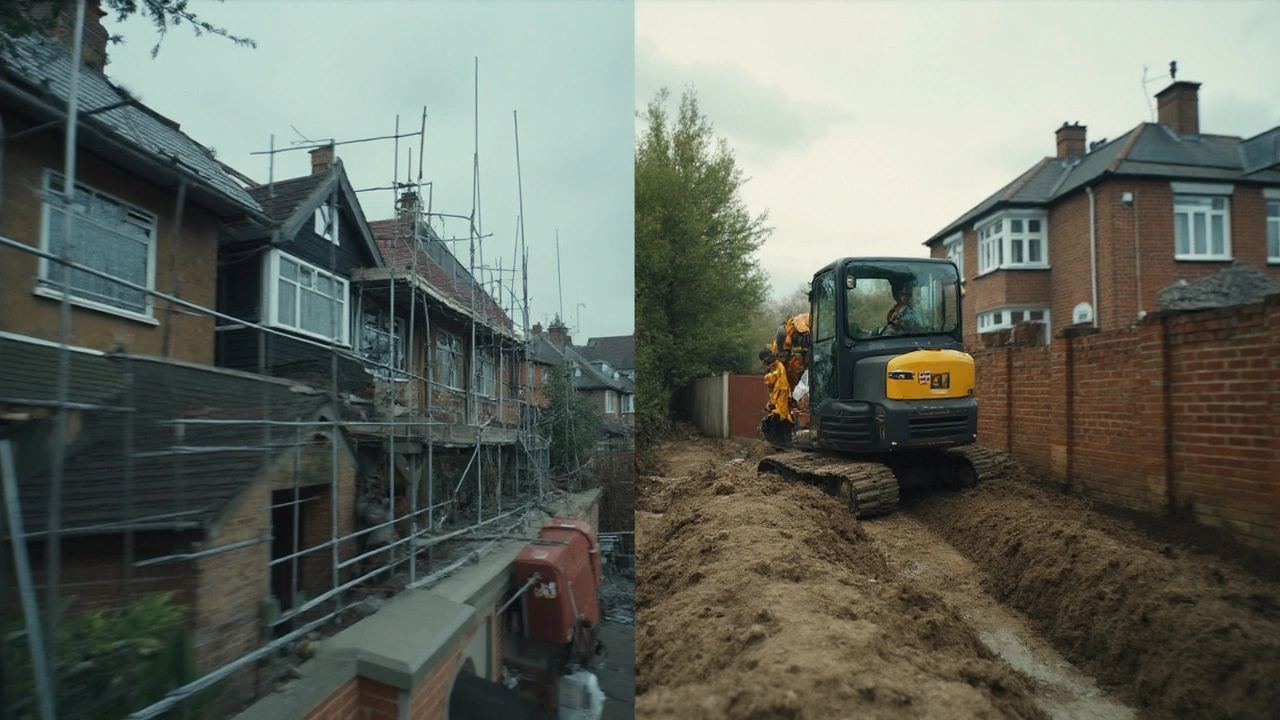Add space the wrong way and you’ll burn cash. Do it right and you’ll get more room for less money, keep the neighbours onside, and boost your home’s value. The straight answer? In the UK, building up is usually cheaper per square metre than spreading out-if your foundations can take the load and the design is simple. But the instant you need underpinning, heavy steels, or complex roof work, the savings vanish. Here’s the no-spin breakdown, with numbers for 2025 and a simple way to choose fast.
TL;DR: Is it cheaper to build up or expand?
- Cheapest per m² (typical): Building up-loft conversions (£1,200-£2,200/m²) and two-storey extensions (blended £1,600-£2,800/m²). Single-storey rear/side extensions sit around £1,800-£3,500/m² depending on spec and location.
- When building up is best: Foundations are sound (confirmed by trial pits), roof shape is simple, you can add a bedroom/bath over existing space, and access for scaffolding is decent.
- When building out is best: You want a big open-plan kitchen/diner with wide garden doors, ground conditions are straightforward, and you’d rather avoid stairs/structural strengthening.
- Gotchas that flip the maths: Underpinning, complex steels, relocating services, limited access, and high-spec glazing can add £10k-£50k+ quickly.
- Planning & VAT: Many extensions fit under Permitted Development with prior approval. Most extension works attract 20% VAT (new builds don’t). Budget 10-15% contingency.
How to decide: a step-by-step cost framework
You don’t need a QS to get a sensible answer. You need the right order of checks. Use this framework to compare options on equal terms.
Job 1: Confirm what’s allowed
- Planning route: Check the Planning Portal rules for Permitted Development (GPDO 2015, as amended). Rear extensions up to 3m on terraces/semis and 4m on detached often qualify, subject to prior approval. Adding an extra storey to certain houses can be permitted under Class AA, but neighbours can object and design limits apply.
- Local constraints: Conservation areas, Article 4 Directions, and listed buildings remove or limit PD rights. Ask your council’s duty planner or an architect.
- Party Wall: If you cut into or build on a party wall, the Party Wall etc. Act 1996 applies. Surveyor fees often run £900-£2,000 per neighbour, per award.
Job 2: Test the structure first, not last
- Foundations: A builder or structural engineer digs trial pits to see footing size/depth and soil. Typical investigation + engineer design: £1,500-£3,500. If foundations are fine, building up stays cost-effective. If not, underpinning/piles can add £300-£1,000 per linear metre.
- Existing walls/roof: Simple roof forms lower costs. Complex hips/valleys, chimneys, and heavy spans push steel costs up.
Job 3: Compare like-for-like with a simple formula
Use this quick cost model (2025 UK typical ranges):
Total project cost = Build cost + Professional fees + Statutory + VAT + Contingency
- Build cost: Use the per m² ranges below, adjust for spec and region.
- Professional fees: Architect/technologist (6-10%), structural engineer (£1.5k-£5k), building regs, and surveys.
- Statutory: Planning fee (or prior approval), party wall, sewer build-over agreements (if within 3m of a public sewer).
- VAT: Most extensions are standard-rated at 20%.
- Contingency: 10-15% for traditional build; 5-10% if design-and-build with fixed scope.
Job 4: Put numbers to both options
Work up two totals and divide by usable new floor area:
Cost per usable m² = Total project cost / Net added m²
Now you can compare a two-storey 30m² (15+15) extension vs a single-storey 20m² kitchen-diner on level terms.
Job 5: Value and disruption
- Value uplift: Extra bedrooms and bathrooms tend to add more resale value than extra living space. Nationwide’s long-standing research suggests an extra bedroom can add around 10%+ to value (location-dependent). Check local comparables on Land Registry/Rightmove.
- Disruption: Building up often needs more scaffolding, stair reconfigurations, and temporary decants. Ground-floor expansions can sometimes be fenced off so you can live in part of the house.
Sources used for cost context and rules: RICS BCIS 2024/25, UK Planning Portal (GPDO), Party Wall etc. Act 1996, Nationwide House Price Index commentary, and typical North West tender data.

Real-world scenarios and numbers (UK 2025)
I’m in Manchester, and prices here sit below London but above some rural areas. The ranges below reflect typical 2025 contractor-led tenders with mid-level specs. High-end glazing, bespoke joinery, and MVHR push to the top of the ranges.
Baseline cost ranges (ex VAT)
- Loft conversion (dormer): £1,200-£2,200/m²; £40k-£70k for a typical 25-35m² dormer, excluding premium finishes.
- Two-storey extension: Blended £1,600-£2,800/m² across both floors. The upstairs m² is cheaper because you’ve already paid for foundations and the roof.
- Single-storey extension (rear/side): £1,800-£3,500/m²; kitchens with large openings/glazing trend high.
- Add a new storey to a bungalow: £2,000-£3,500/m²; roof removal/rebuild and structural work dominate.
| Option | Typical cost per m² (UK 2025) | Common fixed costs | Typical duration | Planning risk | Notes |
|---|---|---|---|---|---|
| Loft conversion (dormer) | £1,200-£2,200 | Scaffolding £3k-£10k; SE £1.5k-£3k | 6-10 weeks | Low-medium (often PD) | Great for an extra bed/bath; minimal loss of garden |
| Two-storey extension | £1,600-£2,800 (blended) | SE £2k-£5k; party wall £1k-£4k | 16-24 weeks | Medium (design/overlooking) | Upstairs m² cheaper; check foundations early |
| Single-storey rear/side | £1,800-£3,500 | Groundworks £5k-£20k; drains £1k-£5k | 12-16 weeks | Low-medium (often PD) | Best for kitchen/diner; big openings add steel cost |
| Add a new storey (bungalow) | £2,000-£3,500 | Roof removal £8k-£25k; scaffolding wrap | 20-28 weeks | Medium-high (mass/height) | Great value if footings are robust |
Example A: Semi-detached in the North West
Goal: Add a bedroom and a bigger kitchen-diner.
- Option 1 - Single-storey 20m² kitchen-diner: Build £45k-£65k + kitchen £12k-£25k + fees/statutory £6k-£10k + VAT; total £77k-£120k.
- Option 2 - Two-storey 30m² (15 up/15 down): Build £55k-£85k + kitchens/bath £15k-£30k + fees/statutory £8k-£12k + VAT; total £95k-£150k. Per m², it’s lower; total is higher but you gain a bedroom which usually lifts value more.
Example B: Terrace with shallow foundations
Trial pits show marginal footings. Building up needs underpinning at ~£400/m run. On 8m of wall, that’s ~£3.2k-£8k plus making good, often more with services. That extra line item can erase the usual saving of going up. In this case, a single-storey rear extension under PD with light groundworks may come out cheaper and quicker.
Example C: Loft vs build out
Loft (dormer) 30m² at £1,600/m² = £48k build. Add fees/statutory £6k-£10k and 20% VAT where applicable; budget ~£65k-£75k. Single-storey 30m² kitchen-diner at £2,400/m² = £72k build + kitchen + VAT; often £100k+. If what you need is a bedroom and shower room, the loft wins on cost and value most of the time.
Regional notes
London/South East tend to run 15-35% higher than the North West. Rural sites can be cheaper on labour but pricier on logistics. Tight access raises costs everywhere.
Energy and regs (Part L, Part O, Part B)
Since the 2022 uplift, extensions must meet higher fabric standards. Expect more insulation and better glazing (lower U-values). Upstairs rooms must consider overheating (Part O), especially with big south-facing glazing. Fire safety (Part B) may require escape windows or protected stairways.
Checklists, rules of thumb, and a quick decision tree
Fast rules of thumb
- If foundations are confirmed adequate, building up is usually 10-25% cheaper per m² than building out for the extra floor area created.
- Lofts are the cheapest “build up” if your roof pitch/height works.
- Kitchen/diner ambitions (big openings, fancy glazing) push single-storey costs to the top of the range.
- Stairs eat 3-5m²; factor that in when adding a storey.
- Preserve garden? Go up. Need open-plan living? Go out.
Cost checklist (tick before choosing)
- Measured survey + drawings (existing and proposed)
- Trial pits + structural engineer report
- Drain survey if near public sewers (build-over agreement if within 3m)
- Planning route confirmed (PD/prior approval or full planning)
- Party Wall notices/awards if shared walls involved
- Services: boiler flue, MVHR, meters, soil stacks-relocations priced
- Temporary works and access (scaffolding, site setup)
- Professional fees, VAT, 10-15% contingency added
Specification choices that move the needle
- Structure: Fewer steels and shorter spans = cheaper. Timber/twin-wall studs beat heavy steel frames on cost and speed in many domestic cases.
- Openings: 3m sliders are cheaper than 6m bi-folds. Go standard sizes to avoid bespoke premiums.
- Roof: Simple warm roof or trusses beat complex hips/valleys.
- Services: Keep kitchens/baths close to existing stacks to avoid rerouting costs.
- Finishes: Mid-spec kitchens/baths can halve the variance.
Decision tree (simple and honest)
- Do you primarily need a bedroom/bath? → Check loft first. If loft viable, pick loft. If not, consider two-storey.
- Do you primarily need kitchen/living space? → Single-storey out is often best.
- Are foundations confirmed adequate? → If yes, building up likely wins on per m² cost. If no or unknown, price underpinning/piles; building out may win.
- Is garden space precious or site coverage limited? → Go up.
- Need to live in during works? → Single-storey can be easier to phase than adding a full new storey.
Pitfalls to avoid
- Skipping trial pits. Guessing foundations is how budgets blow up.
- Ignoring VAT and professional fees in early comparisons.
- Overspec’ing glazing. A 6m opening needs serious steel and thermal detailing.
- Forgetting stairs in build-up options. They take space and money.
- Underestimating party wall timelines. Start notices early.

Mini‑FAQ and next steps
Is building up always cheaper?
No. It’s cheaper per m² when foundations are sound and the design is simple. The moment you need underpinning, heavy steels, or a complex roof, the advantage fades.
Do I need planning permission to build up?
Sometimes no-Class AA allows additional storeys on some homes under Permitted Development with prior approval. But there are height, design, and neighbour privacy limits. Conservation areas and flats are excluded. Check the Planning Portal and your LPA.
Can I live in the house while work happens?
Often yes for single-storey extensions. For adding a storey, builders may need roof-off periods; some clients move out for a few weeks to control dust and speed up work. Factor short-term rent if needed.
How long does it take?
Loft: 6-10 weeks. Single-storey: 12-16 weeks. Two-storey: 16-24 weeks. New storey on a bungalow: 20-28 weeks. Add design, approvals, and procurement time (8-16 weeks) before site start.
What about energy rules?
Part L requires higher insulation and efficient glazing. Part O covers overheating risks in upper floors. You might need trickle vents, shading, or different glass. Your designer will do a SAP assessment.
Will adding a bedroom add more value than a larger kitchen?
Usually, yes. Nationwide’s analysis has long shown extra bedrooms increase value materially. Check local sales data-adding a third or fourth bedroom often unlocks a new buyer pool.
Any tax reliefs?
Most extensions are 20% VAT. Listed buildings and some energy measures have exceptions. New builds are zero-rated, but that’s not an extension.
How many quotes should I get?
Three comparable quotes with the same drawings and spec. Avoid “ballpark” numbers that omit prelims and VAT.
Next steps (do this in order)
- Write a clear brief: bedrooms vs living space, must-haves vs nice-to-haves.
- Get a measured survey and concept sketches for both options (up vs out).
- Commission trial pits and a structural review.
- Agree the planning route (PD/prior approval or full planning) with your designer.
- Develop a spec that fixes the main cost drivers: structure, openings, roof, kitchen/bath.
- Issue the same pack to 3-4 vetted builders. Ask for a programme and exclusions.
- Add fees, statutory costs, VAT, and 10-15% contingency. Now compare the true totals.
- Lock scope, then start. Scope creep is what wrecks budgets.
Manchester/North West tip: Up here, I often see lofts and modest two-storey side/rear extensions win on value for money because foundations tend to cope and access for scaffolding is decent. In tight terraces with unknown footings, single-storey rear extensions under Permitted Development are usually the safer bet.
Bottom line: If you need living space, building out is the clean, predictable route. If you need bedrooms and your structure can take it, building up delivers the best £/m² and protects your garden. Price both with the same assumptions, include VAT and fees, and let the numbers-not guesses-decide. If you only remember one phrase, make it this: build up vs expand cost comes down to foundations, spans, and glazing. Nail those, and you’ll nail the budget.
